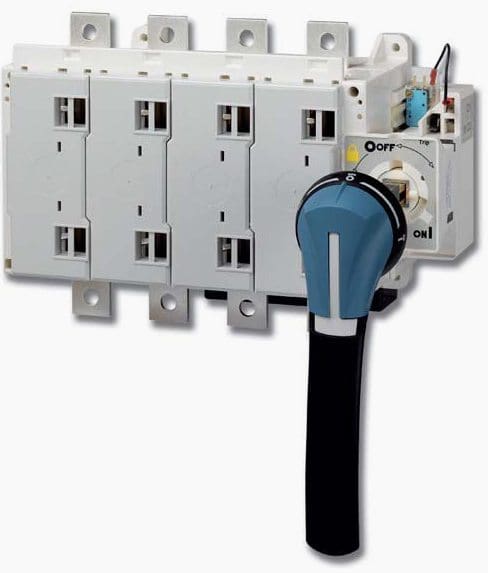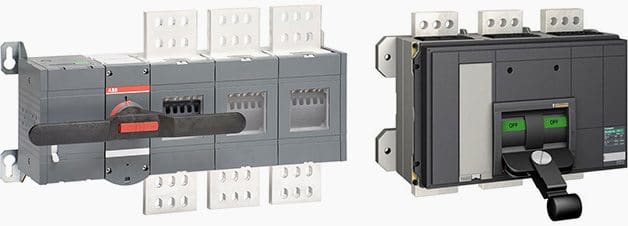Device Types
Various types of devices are available for carrying out the switching and protection tasks listed under a title that are specially designed to fulfill the respective requirements. The various parts of IEC 60947 (Low voltage switchgear and controlgear) specify the design, performance, and test features of the devices.

The most important features of the main device types are presented below:

1. Disconnectors (isolating switches)

The disconnector is a mechanical device that fulfills in the open position the requirements specified for the isolation function (IEC 60947-1).
The key factor here is the opening distance. Isolation must be guaranteed from pole to pole and from input to output, whether this is by means of a visible isolation gap or by suitable design features within the device (mechanical interlocking mechanism).
A device fulfills the isolating function stipulated under IEC 60947-1 when in the “Open” position the isolation at a defined withstand voltage is assured between the open contacts of the main circuit of the switchgear.
It must also be equipped with an indicator device in relation to the position of the movable contacts. This position indicator must be linked in a secure, reliable way to the actuator, whereby the position indicator can also serve as actuator, provided that it can only display the position “Open” in the “OFF” position, when all moving contacts are in the “Open” position. This is to be verified by testing.
According to IEC 60947-3, an isolator must only be able to make and break a circuit, if either a current of negligible size is switched on or off, or if during switching no noticeable voltage difference between the terminals of each pole occurs.
Under normal conditions it can conduct operational currents as well as under abnormal conditions larger currents (e.g. short-circuit currents) for a certain period.
The isolator function can be realized with a variety of devices such as for example in disconnectors, fuse-disconnectors, switch-disconnectors, fuse-switch disconnectors and circuit breakers with isolating function.
2. Load switches

Load switches (or only “switches”) are mechanical switching devices capable of making, carrying and breaking currents under normal circuit conditions which may include specified operating overload conditions and also carrying for a specified time currents under specified abnormal circuit conditions such as those of short-circuit.
Short-circuit currents can be conducted (high short-circuit withstand capacity), but not be switched-off.
For load switches the range of designs is similarly wide as for isolator switches, for example “normal” (load) switches, fuse-switches, circuit breakers.
Fuse-switches are not legally permitted in all countries.
3. Switch disconnectors

Switch disconnectors combine the properties of (load) switches and disconnectors. In this case, too, there are a variety of designs such as “normal” switch disconnectors, fuse- switch-disconnectors and circuit breakers.
Fuse-switch-disconnectors are not legally permitted in all countries.
4. Circuit breakers

Circuit breakers are mechanical switching devices, capable of making, carrying and breaking currents under normal circuit conditions and also making, carrying for a specified time and breaking currents under specified abnormal circuit conditions such as those of short-circuit (IEC 60947-2).
They thus also fulfill the requirements of (load) switches. Circuit breakers are often designed so that they can fulfill the requirements for disconnectors.
Reference: Low-Voltage Switchgear and Controlgear – Rockwell Automation











I am not seeing any purpose of the Switch disconnectors. I mean when the load switch will open, it would isolate the main circuit of the switchgear automatically.
Can you clear the the purpos of it more?
Thank you
I should be able to provide a scenario for the purpose of switch disconnectors with regards to the UK railway. The railway’s devices may look a little bit different, but they are the same function as this article.
From a railway perspective, each overhead line electrical section is supplied via circuit breakers. Because these electrical sections are typically in the 10’s of miles long, there are times when it may be necessary to reduce the electrical section (typically when maintenance is being completed or there is an incident). Because of this, the electrical sections are typically split into multiple sub-sections where these sub-sections are traditionally electrically separated via switch disconnectors. For instance, think of station areas where typically every platform will be it’s own sub-section.
The switch disconnectors are used as they are cheap and simple, however they have the drawback that they are not load-breaking. Thus to use these disconnectors, the circuit breaker is to be opened first before the switch can be opened (to ensure the life of the disconnectors), with the circuit breaker re-closed after all relevant disconnectors are opened. Take note that new electrification schemes in the UK are now installing load-break switches instead of switch disconnectors such that the process I mentioned is not required.
Hi there what is the switch is a load or no
Someone can explain to me which is the main function of SDF – Switch Disconnector Fuse?
Am so glad for providing this articles to help reposition someone like me in the field of Electrical
More grease to your elbow
Thank you Neil!
how to select size of isolator(Ampere rating) as per IEC . please tell me any one.
Hi,
Can you please let me know how can we select the rating of Disconnector switch in primary of Power transformer e.g for 630KVA pole mounted transformer, what will be the Disconnector or LBS rating will be?
for shortcut:
– disconnect switch working (ON-OFF) in no load, if opened while circuit loaded, bad arc will be happened.
– load break switch working (ON-OFF) with normal rated load, can not make or break the circuit, means that it can not work (withstand) in case of faults or short circuits.
– circuit breaker work (ON-OFF) on normal load, and can make and break the circuit in case of faults.
Thank you Edvard! I’ve been looking for this info, and you summed it up very nicely.
Many thanks
Thank you Mr Csanyi. I needed that clear and concise summary. Perfect!
:-)
Best regards.
many thanks
Mr. Edvard Csanyi, May I know what are the requirements for “isolating function stipulated under IEC 60947-1 when in the “Open” position the isolation at a defined withstand voltage”. Unless this is defined, the subject is not fully understood. What you have done is simply quote from IEC and nothing more.
Mr Sivakumar, The information you ask for is contained within IEC 60947, or if not, the source document is refered to in IEC 60947. (I actually forget which alternative is correct, I apologize.)
It is useful to become accustomed to reading these standards. They are boring, precise and leave nothing to the imagination. They try to make things as black-and-white as possible.
As an engineer, it is also useful to become accustomed to searching for answers, and most importantly, don’t stop at the first answer you find – there might well be a better one around the corner!
Best regards.
many thanks sir
Very thanks it’s good update knowledge and Information
Thanx for your valuable articles and info sir.suggest some new courses regarding switch gear and protection
Thanx for the article sir…whould you like to share some
benefitial courses after the BE electrical engg. Yaser tanweer BE MBA
Many thanks for the v.useful article valuable effort sir
Sir,many thanks for such useful technical information –Lohare BE MBA
It is good to update knowledge ang technogy
better study site for electrical as far as i know.
got lot of articles among all the electrical equipments
Many thanks;